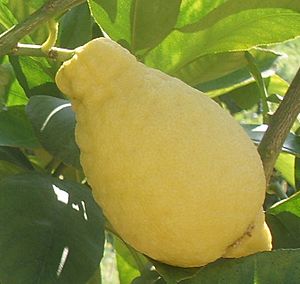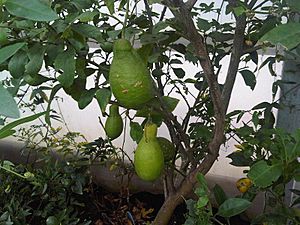Lumia (citrus) facts for kids
Quick facts for kids Lumia |
|
|---|---|
 |
|
| Species | Citrus × lumia Risso & Poit. |
| Cultivar | 'Lumia' |
The lumia is a special kind of citrus fruit. People sometimes call it the pear lemon because its shape often looks like a pear. It can also be known as the French lime or even the sweet lemon, even though it's not always sweet.
In different languages, the lumia has many names. In German, it's called Birnenlimone. In French, it's Poire du commandeur. In Chinese, it's Lu mi, and in Japanese, Rumii.
This fruit often looks like a pear. It has a thick peel and doesn't have a lot of juice inside. Like a citron, the lumia can grow to be very large!
A Special Lumia: Pomum Adami
There is a special type of lumia called Pomme D'Adammo. It is also known as Adam's apple. This variety is also part of the Citrus lumia family.
The Lumia's Family Tree
The lumia likely first grew in the Mediterranean area. Some scientists classify the lumia as a type of lemon. Others think it is more like a citron.
Lumias are actually different kinds of citrus mixes. They are often thought to be a mix with a citron. This is because of their large size, thick peel, and not-so-juicy inside. An old book by Johann Christoph Volkamer described a lumia called Pomo d'Adamo as a "citron hybrid."
Recent studies have looked at the DNA of many citrus fruits. These studies show that different lumias have different parent plants. For example, one type called 'Hybride Fourny' is a mix of a citron and a pomelo. Another, the 'Jaffa lemon', is a more complex mix of these two. The Pomme d'Adam came from a citron and micrantha mix. Other lumias, like the ‘Borneo’ and ‘Barum’ lemons, are mixes of citron, pomelo, and micrantha.
A citrus expert named Hodgson wrote about lumias. He said they are natural mixes. They show traits of both acid citron or lemon and pomelo. He noted their large, often pear-shaped fruits. They have greenish, sour flesh. Their flowers are large and purple-tinged. The young shoots are also a bit hairy and purple. He mentioned that main types include "Poire du Commandeur," "Citron de Borneo," and "Pomme d'Adam." These fruits are very old. Their exact origin is unknown, but it's likely Italy. Today, they are mostly grown as interesting plants or for decoration.
Lumia and Health
Scientists have studied the lumia fruit. A Japanese study from 1996 looked at its peel. The study found that a part of the lumia's inner peel, called the albedo, had a special activity. This activity might help with certain body processes. The outer peel of a ripe lumia also showed similar activity. This was more than the juice inside the fruit.


